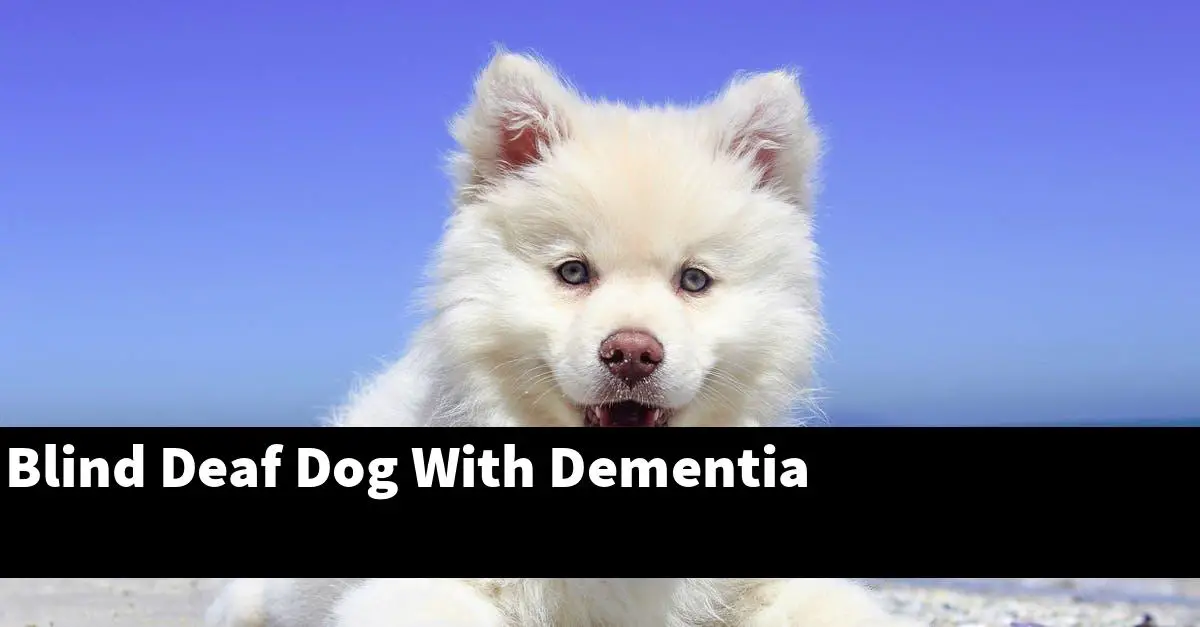Blind, deaf dogs with dementia may be prone to anxiety and may benefit from medication and behavior modification.
The article will be discussing a blind deaf dog with dementia and how the owners are coping with the situation.
Table of Contents
What are some common symptoms of dementia in dogs?
There are a few common symptoms of dementia in dogs. One is a loss of interest in activities that used to be enjoyable, like playing fetch or going for walks. Another is a change in sleeping patterns, either sleeping more or less than usual. Additionally, some dogs with dementia may become agitated or anxious, and may start to pace or wander aimlessly. Some may also experience a loss of appetite or weight loss.
How can you tell if a dog is blind or deaf?
There are a few ways to tell if a dog is blind or deaf. One way is to see if the dog responds to visual cues, such as hand signals or movement. If the dog does not react to visual cues, it may be blind. Another way to tell if a dog is blind is to see if it bumps into things or has trouble finding its way around. A third way to tell if a dog is deaf is to see if it reacts to noise. If the dog does not react to noise, it may be deaf.
How do you care for a blind or deaf dog with dementia?
Assuming you would like tips on how to care for a blind or deaf dog with dementia:
One important thing to keep in mind when caring for a blind or deaf dog with dementia is to make sure they feel safe and secure. This can be done by creating a safe space for them in your home, which may include things like baby gates to block off stairs or certain areas of the house, and keeping a consistent routine. It’s also important to provide them with plenty of mental and physical stimulation through things like exercise, training, and interactive toys.
Here are some more specific tips:
-When walking a blind dog, use a harness instead of a collar and leash so you can have more control and help guide them.
-For deaf dogs, hand signals can be used for commands instead of verbal cues.
-Make sure food and water bowls are in the same place every day, and put them in an easily accessible spot.
-Increase the amount of lighting in your home to help a blind dog get around, and use rugs or mats to help a deaf dog feel vibrations.
-Consider using a pet camera so you can check in on your dog while you’re away, and get help from a professional if you need it.
What are the challenges of living with a blind or deaf dog with dementia?
There are a few challenges that may arise when living with a blind or deaf dog that also has dementia. One challenge is that the dog may become disoriented and lost more easily, as they cannot see or hear cues from their surroundings. This can lead to them getting stuck in places or getting lost outdoors. Another challenge is that the dog may become more anxious and stressed, as they cannot process information from their environment in the same way as they used to. This can lead to them becoming agitated and even aggressive. Finally, the dog may have a hard time communicating their needs, as they cannot see or hear to understand what you are saying. This can make it difficult to care for them properly.
How do you help a blind dog with dementia?
Dogs with dementia may experience a decline in their ability to think, remember, and learn. This can be frustrating and confusing for both the dog and their owner. While there is no cure for dementia, there are ways to help your dog live a comfortable life.
If your dog is blind and has dementia, it is important to keep their environment as consistent as possible. This means keeping their food and water in the same place, their bed in the same spot, and their toys in the same locations. This will help your dog orient themselves and feel more comfortable.
You should also continue to provide your dog with mental stimulation. This can be in the form of interactive toys, puzzle feeders, or even simple obedience training. Keeping your dog’s mind active will help slow the progression of dementia.
Finally, be patient and understanding with your dog. They may not be able to remember you or their favorite toy, but they still love you just as much. Dementia is a difficult disease for both dogs and their owners, but with patience and love, you can help your dog live a happy life.
What are the final stages of dementia in dogs?
There are four final stages of dementia in dogs: Disorientation, Sleep Disturbances, Anxiety and Depression, and Loss of Interest.
Disorientation is when a dog becomes lost in familiar surroundings and is no longer able to recognize people or other animals. They may also wander aimlessly and have difficulty finding their way back home.
Sleep Disturbances are common in the later stages of dementia and can include insomnia, restless sleep, and daytime napping.
Anxiety and Depression are often seen in dogs with dementia as they begin to lose interest in things they once enjoyed and may become withdrawn and less social.
Loss of Interest is the final stage of dementia where a dog will lose interest in all activities, including food and water. They may also stop responding to verbal cues and become unresponsive to their environment.
How do you know when to put a dog down with dementia?
The decision to euthanize a pet is never easy, but it is sometimes necessary. When a dog is suffering from dementia, it is important to consider the quality of the dog’s life. If the dog is no longer enjoying life and is in pain, it may be time to euthanize. Other factors to consider include the dog’s age, health, and behavior. If the dog is aggressive or is having difficulty moving around, euthanasia may be the best option.
Do dogs with dementia suffer?
There is no one answer to this question as it depends on the individual dog and the severity of their dementia. However, it is generally accepted that dogs with dementia do suffer from the condition. The main symptoms of dementia in dogs are loss of cognitive function, disorientation, changes in sleep patterns, and increased anxiety. These symptoms can cause a great deal of distress for dogs and their owners. There is currently no cure for dementia, but there are some treatments that can help to improve the quality of life for dogs with the condition.
Summary
– Dementia in dogs is a progressive disease that leads to cognitive decline and eventually death. There is no cure, but there are ways to make your dog more comfortable. If your dog is suffering from dementia, you should talk to your veterinarian about your options.


